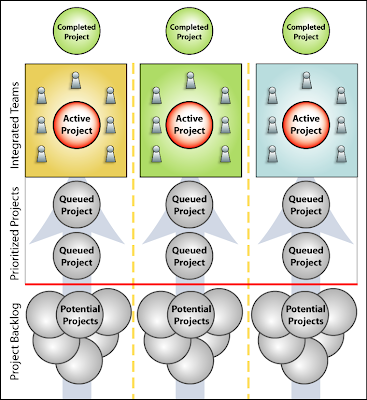Some time ago, I posted my 5Qs on Agile interview with PM Boulevard. In that interview, one of the tough questions was, “what is the biggest challenge to implementing Agile methods?” Now, this is a tough question to answer because there are numerous challenges to implementing Agile – ranging from appropriate organizational readiness and good team member capability to a clear business objective for moving to a new project delivery methodology. Yet, in my personal experience, the toughest challenge we continue to face is the lack of a clear role for middle management. Now, does this mean that Agile negates the need for middle management? No, but it does mean that, just as the roles of project team members change substantially, the role of middle management must change in order for an Agile adoption to be successful over the long haul.
So, over the past 3-4 years, we have been working with selected clients to implement the concept of a Lean-Agile PMO in their organizations. What is the job of a Lean-Agile PMO? It is an organization that is tasked with supporting Agile teams in their transition to and practice of Agile, and ensuring the delivery of customer value across projects and portfolios. The first reaction we get from Agile teams, based on past negative experiences, is that they do not believe a “PMO” can help support them with Agile. We have not found this to be the case. Designed appropriately, and given the right tools and training, PMOs can help be the glue that holds Agile together across many projects, and thereby lifts it to sustainable success in the larger organization. This involves being responsible for:
- Enabling project throughput across the organizational portfolio;
- Assisting teams with resource planning and capacity management;
- Assisting with maintaining team member satisfaction;
- Enabling business customer satifaction across projects in the portfolio; and
- ROI and quality assurance of the Agile process across multiple projects in the portfolio.
What does a Lean-Agile PMO look like, and what is it responsible for? In our experience, some of the characteristics that have made Lean-Agile PMOs successful are:
-
- They use overlapping management to ensure active participation from the executive level, the project teams, and middle management;
- They consider Agile teams to be their customers, not their subordinates;
- They use Lean principles at the portfolio level to optimize resource planning, and project scheduling and servicing;
- They believe that the schedulable unit is the team, not the individual. Thus, they help prioritize and funnel projects to long-standing, high-performing platform-based teams, and do not allocate “resources” to transient projects;
- They assist teams with standardizing Agile practices to ensure reliable project delivery;
- They assist with the delivery of customer value through the design and management of appropriate organizational metrics; and
- They play a heavy role in organizational change management – communicating with stakeholders, managing the right message about Agile adoption; and providing the appropriate resources to Agile teams – training, career development, etc.
Above all, the Lean-Agile PMO provides a clear, value-adding role for middle management in an Agile organization. In November 2006, Roland Cuellar and I published a paper outlining the Lean-Agile PMO based on our early work with clients. At Agile 2007, Ash Tengshe from Capital One Auto Finance presented results on their Agile PMO. At Agile 2008, I’m hoping to hear from others who have embraced and refined this concept. In future posts, I’ll discuss more about the Lean-Agile PMO and its operation.
If you happen to be at Agile 2008, I’ll be happy to discuss it in person. If not, please do comment or email and we’ll respond to any queries.

